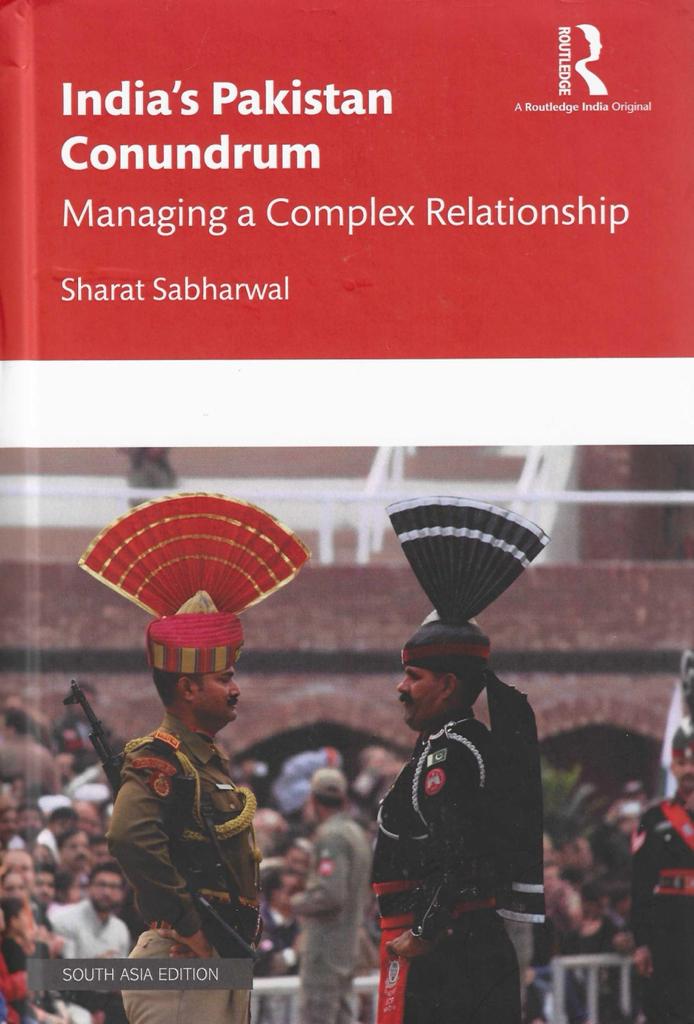BOOK REVIEW: INDIA’S PAKISTAN CONUNDRUM

BY MAJ GEN JAGATBIR SINGH, VSM (RETD)
Pune, 23rd September 2022: Ambassador Sharat Sabharwal has had the unique distinction of managing complex relations between India and Pakistan at crucial junctures as he has served there both as the Deputy High Commissioner from 1995 to 1999 and as the High Commissioner from 2009 to 2013 where he has been witness to various facets of Pakistan both negative and positive. His book ‘India’s Pakistan Conundrum’ published by Routledge is therefore written with the knowledge and insight of a practitioner but also with the wisdom of his depth of knowledge and understanding of the multiple dilemmas that shape the relationship and the book, therefore, brings out a much-needed clarity on key issues that shape this critical relationship. It is a complex subject and the book is aimed as much at providing his perspective as provoking some thought on the issue.
The book is laid out in two parts Part I examines the nature of the Pakistani State and how it impacts India including chapters on religious extremism, the economy which depends on an external patron, the Army which is described as a ‘state within a state’, the Ethnic Fault lines, What drives Pakistan hostility towards India and Whither Pakistan’.
Part II covers key issues of India- Pakistan Relations and India’s Policy Options. This has Chapters on all the major issues including Jammu & Kashmir, Terrorism, Trade, Other Outstanding Issues which includes Siachen and Sir Creek, our Shared Heritage, Engaging with the Real Power Centre, Water, MFN and Pakistan’s fault lines, the nuclear dimension, Isolating Pakistan, the issue of Dialogue versus no dialogue and the Way Forward in Managing the Relationship. Each Chapter has been deeply researched with detailed quotes from various sources to back up his observations.
Pakistan has defined itself as the antithesis of India. It craves parity with India inspite of the differences in size, potential and comprehensive national power. In this quest it has ‘turned itself into a rentier state, ready to do the bidding of an external patron, willing to underwrite its ambitions vis a vis India financially and militarily even at the cost of the interests of its people’.
While writing about religious extremism the author brings out the changes that have taken place in the constitution which included declaring Ahmadis as non-Muslims as well as the traditional Shia- Sunni divide and the divide between the Sunnis between the Deobandis and Barelvis.‘
Religious sentiment has often been pandered to in order to make up for the shortfall in governance’ and ‘ the Army has also provided patronage to different religious parties and groups to advance its agenda within and outside Pakistan’.’ The spread of religious hatred through school textbooks has been a long-standing problem’. Education has become a purveyor of religious extremism.
As regards the economy; ‘ Pakistan’s policy of maintaining an adversarial posture towards India, entails a heavy burden on its economy, which together with the tendency to live grossly beyond its means has forced it to look for an external patron to underwrite its economy’.
The Army has been in direct rule for thirty three years under military dictators but even when not in charge directly it has controlled governance, particularly foreign and security policies. The Army has not lacked in instruments to maintain its iron grip. The DG ISI is next in importance to the army Chief and the ISI ‘has been involved in scuttling democratic functioning and fomenting trouble for inconvenient civilian leaders’.
The Army, apart from controlling the levers of the state directly or indirectly, has also built a large economic empire which in the form of Fauji Foundation, Army Welfare Trust, Shaheen Foundation and Bahria Foundation have diverse business interests. Ironically, in spite of Pakistan’s hostility towards India the Fauji Cement Company exploited a commercial opportunity by exporting a large quantity of cement to India. To paraphrase a quote from Bob Dylan the Army ‘is not ready to fade into its own Parade.’
As regards ethnic fault lines, favouring Punjab at the cost of other ethnicities has given rise to discontent among those oppressed which has in turn manifested as militant ethnic nationalism. The urdu speaking Mujahirs who had spearheaded the Pakistan movement and migrated from their homes in India wielded considerable influence initially, however the shift of power to the Punjabi dominated establishment gradually led to their marginalization. While writing about ‘Baloch nationalism’ he has clearly stated; ‘that the state has depended almost exclusively on force to suppress dissent and has done very little to address the grievances underlying it.
The author quotes former Minister Aitzaz Hussain and states; that Pakistani’s “have been told that their very identity was their un- Indianness: banish this thought from their mind and the country will collapse”. It is in the institutional interest of the Army to sustain this hostility in order to justify itself as the guarantor of Pakistan’s physical and ideological frontiers and maintain its tight control.
The author writes that Pakistan ‘has shown remarkable resilience in the face of adversity’ and as long as the Army remains ‘a largely disciplined and professional force’ having at its disposal a rapidly growing arsenal of nuclear weapons’ it’s unlikely to fail in the near future.
Part II is of course the key to covering Indo – Pakistan Relations to include J&K which is always placed on a higher pedestal in any discussion. However, there is a wide gulf between the positions of India and Pakistan a the trust deficit. Even during the Kargil conflict the Pakistani’s ‘proposed a time schedule for a solution to the Kashmir conflict’ and Sartaj Aziz even proposed that Prime Minister Nawaz Sharif visits India on his return from China at end of June 1999. However, as the military balance shifted in India’s favour this was shelved. In fact, Bruce Reidel also states; “ that Sharif insisted that Pakistan would withdraw its forces provided India committed to settling Kashmir within a specific time frame. ‘If I were the Indian Prime Minister,’ Clinton shot back, ‘I’d never do that.’
There is no doubt that Pakistani policy of cross-border terrorism and the threat to the security of this very sensitive region are very much alive.
Pakistan’s use of proxies to attain its foreign policy objectives is as old as its inception. He says that ‘his interlocutors strongly condemned the Mumbai attacks but beyond that there was an attempt to evade responsibility and play up Pakistan’s sense of victimhood ‘. He writes that the push for placing Pakistan on the FATF grey list came from the US who were keen to pressurize Pakistan for supporting the Taliban but also states that it is ‘ unlikely to be blacklisted by FATF’.
The other issues written about are trade, in early 2021 both the Pakistani civilian and military leadership spoke of ‘geo-economics’ and comprehensive national security as against only military security. It is in Pakistan’s interest to leverage the fast growing Indian economy and build beneficial trade and economic linkages but for that, the overall security situation needs to drastically improve.
On Siachen he says; ‘Pakistan’s reluctance to record the AGPL and almost exclusive focus on demilitarization has remained a hurdle in resolving the issue and also raised doubts on its intentions’. However, with the growing Chinese presence through the CPEC in ‘Gilgit – Baltistan’ the complexities are very different.
As regards people-to-people bonhomie, this cannot ‘transform the nature of relationship’ though it remains an important policy option in conjunction with other instrumentalities.
Ambassador Sabharwal talks of the meeting of the Indian Defence Attaches with Lieutenant General Shuja Pasha the then DG ISI and his proposal ‘to have composite delegations from both sides with civil, military and intelligence officials to discuss various issues.’ However, while it is useful to maintain such contacts it is unlikely to ‘transform Pakistan’s fundamentals in the absence of a strategic shift in their world view.
The nuclear dimension is covered in great detail. Ambassador Sabharwal talks of being summoned along with the then Indian High Commissioner Satish Chandra at midnight on 27 May 1998 by Foreign Secretary Shamshad Ahmad to say that there was credible evidence that India was going to attack their nuclear facilities by a F -16 stationed at Chennai and threatened ‘ massive retaliation’. When told that India does not have F-16’s they said the aircraft ‘could be Israeli’. Pakistan also took up the matter with all P-5 countries in their capitals and through their missions in the UN’. The author feels this was because Pakistan was on the verge of carrying out their nuclear tests and were nervous about their site being attacked or it could also be to divert the world’s attention at a critical time.
However, what I do not agree with is his feeling that Pakistan’s nuclear capability has placed a serious limitation on India’s ability.” Can any responsible leader authorise a consequential conventional military strike, capable of giving a decisive blow to Pakistan, on the assumption that it will not escalate to the nuclear level”. In fact India has the ability to pursue conventional operations under a nuclear umbrella and the disparity in conventional capability is what is worrying Pakistani strategists.
While he has listed out their ‘red lines; the space for decisive conventional military action to bring about change in its behaviour may have shrunk but it has not been eliminated.
The China-Pakistan relationship ’has emerged as its most important one and they both share strategic congruence. It’s multi-dimensional to include arms, nuclear supplies, trade and development of infrastructure through CPEC and the Gwadar port and diplomatically. China has repeatedly backed Pakistan at all international forums including blocking the designation of Azhar Masood as an international terrorist. The China – Pakistan nexus is growing and even though Pakistan is not a significant military threat to India its collusivity with China makes it a part of India’s larger China problem and hence is a serious threat.
There are a few silver linings that are aspects of Pakistan that are either not known or fully understood and he categorically states that Pakistan isn’t disintegrating and that a fractured Pakistan isn’t in the best interests of India as the resulting chaos would not leave us untouched.
He clearly brings out that both people come from the same stock and the Pakistani’s are hardworking and resilient and talented but their positive potential has been stymied by the army-dominated national security state and mindset poisoned by propaganda.
Both countries being immediate neighbours cannot wish each other away. The two countries have talked with the sound of guns looming but loud sounds bring intervention from other countries. He quotes a conversation between Prime Ministers Vajpayee and Nawaz Sharif ‘regarding how third parties serve their own interests’. Being a diplomat Ambassador Sabharwal believes; “diplomacy and dialogue have a place even in a most difficult relationship”.
He also feels that the centrality the Army seeks for itself as the protector of its physical and ideological frontiers and being the final arbitrator is being increasingly questioned by the civil society, media, judiciary and political leadership. But the removal of Prime Minister Imran Khan demonstrates that the Army remains in control.
The Pakistani establishment and particularly the Army see India as its ‘eternal threat’ and ‘eternal enemy’ and perceive an existential threat from India. This is despite Prime Minister Atal Bihari Vajpayee visiting Minar-e – Pakistan during his bus yatra to Lahore and saying that the two countries had to learn to coexist and work together for peace and prosperity’. The Kargil intrusions soon thereafter put paid to any further dialogue in keeping with the Lahore understandings.
Today unless Pakistan changes it has the choice of making increasing budgetary allocations to its armed forces and going broke or persuade China to underwrite its expenditure and in return serve their interests.
However, he writes; there is work to be done at home to change their behaviour ‘by equipping ourselves better to counter its hostile actions and denying it the opportunity of fishing in troubled waters in Kashmir’. It is undoubtedly an extremely well written and detailed book which will serve as a valuable reference for those readers who wish to have a deeper understanding of Pakistan.








